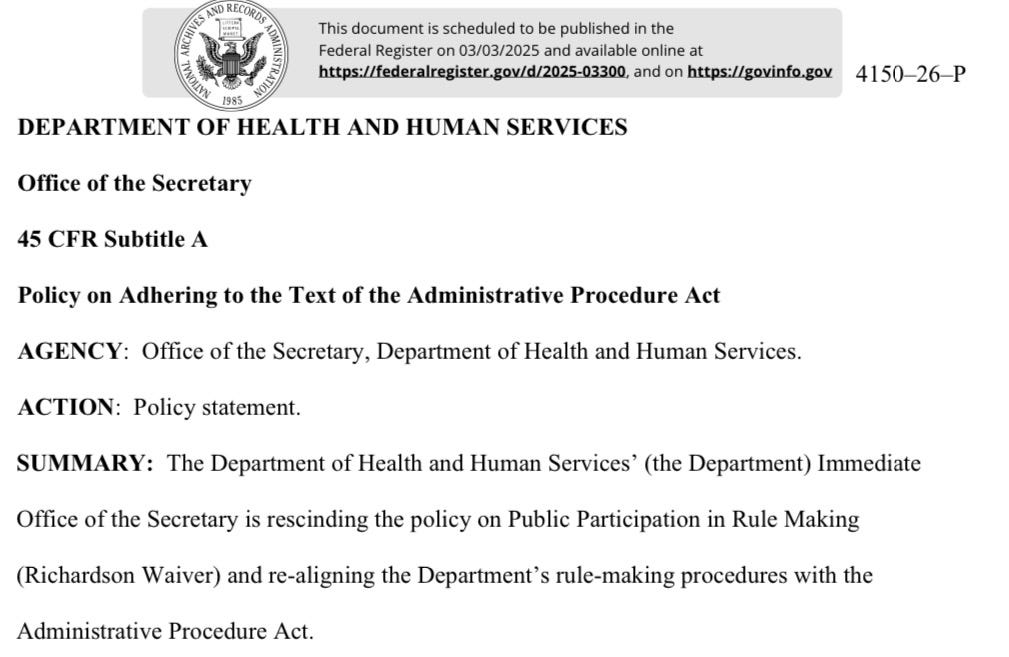The HHS Shift: A Return to Administrative Basics
On a crisp morning in late February 2025, as government offices stirred to life across Washington D.C., a significant shift in regulatory philosophy was taking shape within the halls of the Department of Health and Human Services. Secretary Robert F. Kennedy, Jr. had just signed a policy statement that would fundamentally alter how the massive federal agency approaches its rulemaking responsibilities. The change, though procedural in nature, speaks volumes about the current administration's regulatory vision and priorities.
For over five decades, HHS had operated under what insiders called the "Richardson Waiver," named after former HHS Secretary Elliot Richardson who implemented it in 1971. This self-imposed policy required the Department to follow the full notice-and-comment rulemaking procedures for virtually all of its actions, even when federal law—specifically, the Administrative Procedure Act (APA)—explicitly exempted certain categories from these requirements.
The Richardson era represented a time when expanded public participation was viewed as inherently beneficial, regardless of efficiency costs. Under this policy, even when crafting rules about grants, benefits, contracts, or internal agency management, HHS voluntarily subjected itself to a process that could take months or even years: publishing proposed rules, accepting public comments, reviewing each submission, and crafting detailed responses before finalizing any action.
But times and administrations change. Secretary Kennedy's policy statement frames the Richardson Waiver as more burden than benefit—a well-intentioned but ultimately counterproductive constraint on the Department's ability to fulfill its mission efficiently. The statement characterizes the waiver as "contrary to the clear text of the APA" and argues that it "imposes costs on the Department and the public, is contrary to the efficient operation of the Department, and impedes the Department's flexibility to adapt quickly to legal and policy mandates."
The timing is notable. As healthcare challenges continue to evolve rapidly post-pandemic, the administration clearly seeks greater nimbleness in how it addresses emergent issues. The document reflects a certain pragmatism—a belief that sometimes, procedural efficiency serves the public interest better than procedural maximalism.
Critics will undoubtedly view this change through a political lens, seeing it as part of a broader effort to reduce regulatory barriers or limit public input. Supporters will likely frame it as simply adhering to the letter of the law as written by Congress in the APA, which explicitly carved out these exemptions for practical governance reasons.
What remains unaddressed in the terse, legalistic document is how the Department will balance competing values moving forward. While the policy gives HHS components "discretion" to still use notice and comment when appropriate, it offers little guidance on when such additional procedures would be warranted versus when expediency should prevail.
As this policy takes effect, the true test will lie in how the Department wields its newly reclaimed flexibility. Will it use these streamlined procedures judiciously to address truly time-sensitive matters? Or will significant policy changes increasingly occur without the formal public feedback mechanisms that have become standard practice across the federal government?
For now, the Richardson Waiver slips into history, ending an era of administrative practice at one of the government's largest departments. In its place emerges a more textual approach to the APA—one that embraces both the requirements and the exemptions that Congress built into the administrative state. Whether this marks the beginning of a broader shift across government or remains unique to HHS under its current leadership remains to be seen.


